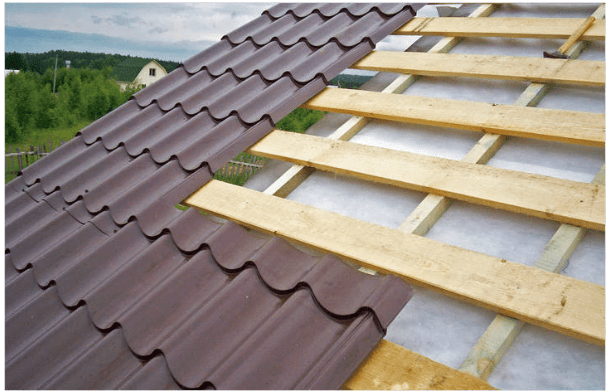The construction market today offers a wide selection of roofing materials. If earlier you had to choose between expensive, high quality and cheap with a short service life, today manufacturers offer many alternatives that are an excellent combination of cost and quality. And one of them is a metal tile. It quickly became popular with buyers due to its low price and more than decent performance.
Manufacturing features
Before proceeding to the description of the pros and cons of metal tiles, it is worth understanding what it is. It is made from cold-rolled sheet steel with a thickness of 0.4 – 0.5 mm. To give it a relief that makes it look like a ceramic roof, the sheets are passed through a molding machine. The presence of a profile not only improves the aesthetic properties of the metal tile, but also gives it rigidity and enhances resistance to external mechanical influences.
It is worth saying that the price will be different from the manufacturer’s company and from the area that you need to cover the house. Therefore, before making calculations, you need to find out how much this or that type of metal tile costs. The thickness of the metal will also affect the price. The thicker, the more it will cost. In addition, this should include the complexity of the shape of the roof, as well as the type of protective and decorative polymer coating. So, before making an order, you should to know cost to install metal roofing, this is very important, because any miscalculation will hit your pocket.
Further, the roof is treated with zinc or aluminum zinc on both sides. High-quality roofing sheets have at least 270 grams of galvanization per square meter. Zinc is the first step in corrosion protection. But since by itself it is not very resistant to external influences and tends to lose its protective properties over time, conversion protection, primer and a polymer coating are additionally applied to the sheets on the front side. It is it that is responsible for protecting the metal from external influences.
The polymer coating may be different. First of all, various visual effects that can be created on the roof depend on its appearance. For example, to give the tiles a deeper color, a texture close to natural ceramics, dullness, and so on. And it also affects the “adaptability” of the roofing material to different weather conditions (resistance to ultraviolet radiation, acid rain and others. The most popular is polyester coating. It is suitable for use in regions with different climates and is inexpensive. Plural is in second place – it allows tiles to retain brightness and color saturation for a very long time, as well as to use tiles in a wider temperature range.
Now that you have an idea of what a metal tile is, you can move on to its advantages, which directly follow from the materials and technology of its manufacture.
Advantages of metal tiles
There have been a lot of them.
- Profitability . Given its relatively low cost compared to other roofing materials and a service life of 30-50 years, it turns out to be a very profitable investment.
- Resistance to external factors . The metal tile thanks to the structure transfers well to any climatic conditions. It can be used in regions with a harsh and hot climate, including coastal areas. She is not afraid of mechanical influences and has a fairly low windage so that you don’t have to worry about the roof being blown away during a hurricane. There is only one chance in ten for this.
- Fairly simple installation . For such a roof, no special preparation of the base is required. A classic wooden frame will suffice. Yes, and the installation of tiles can be done independently, if you have the appropriate building skills.
- Light weight . One square meter of metal tile has an average weight of up to 6 kg. This again makes laying easier and also greatly facilitates the transport of the material. In addition, light weight does not create a large load on the walls of the construction site, its foundation and roof rafters, which allows it to be used for arranging roofs of any size. Including, apply it to the restoration of historical buildings.
- Fire safety. The metal does not burn and does not support the combustion process, like all other materials used to create metal tiles.
And, of course, we must not forget about the excellent aesthetic properties. As mentioned above, the polymer coating is used in different ways, which makes it possible to produce a metal roof not only in a wide variety of colors, but also with different visual effects.
Disadvantages of metal roofing
Perfection, as you know, does not exist, so before you finally opt for this material, you should know a few important nuances. The metal tile has a high thermal conductivity, which can be especially well experienced in hot weather. But this problem can be prevented by laying a thick layer of insulation at least 15-20 cm. It is best to use mineral wool.
Also, some note the noise of metal tiles during rain. However, for most this is not something significant. If the installation was done correctly, the noise will not be too strong and after a while you will simply stop paying attention to it.
In addition, it is important to know that if you want to create a roof with a complex configuration, then be prepared for a high material consumption. Although it is not uncommon that even under this condition, buying more metal tiles is cheaper than if you chose a different roofing material (even adapted for complex roofs).


